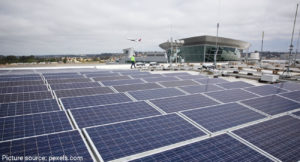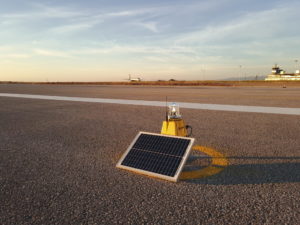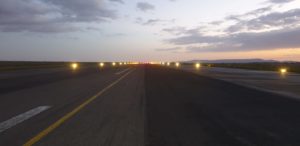It’s Time for Generational Change or Wired vs. Solar Airport Lighting
| Company | S4GA |
|---|---|
| Date | 21.05.2019 |
The safety of people is always and everywhere the basic and most important principle in all aviation operations. The only exceptions are military and rescue operations, when the ‘vis maior’, forces of higher rank expose the lives of pilots to a danger, but even then this rule is always applied. The brutal and banal truth is that good and versatile training of a combat or rescue pilot takes many years and the best possible protection of his life is also a must.
Navigational aids are almost as old as aviation
 The most dangerous phase of any flight is landing when the risk of a disaster is greatest. The velocity of touchdown of even a small and light aircraft is always high, as well as the forces acting on it. A prerequisite for safe landing and take-off is good visibility that allows the pilot to determine most precisely its position in three-dimensional space and accurately recognize and control the dynamics of changes of the position. Modern navigational systems practically make passenger and military traffic independent of the time of day and weather conditions, but airport that is not equipped with ILS must simply see the airport much earlier in order to be able to safely take off and, in particular, land. Airport lighting enabling flight operations at night or/and with limited visibility has been operating successfully for over 100 years (since 1918 to be exact).
The most dangerous phase of any flight is landing when the risk of a disaster is greatest. The velocity of touchdown of even a small and light aircraft is always high, as well as the forces acting on it. A prerequisite for safe landing and take-off is good visibility that allows the pilot to determine most precisely its position in three-dimensional space and accurately recognize and control the dynamics of changes of the position. Modern navigational systems practically make passenger and military traffic independent of the time of day and weather conditions, but airport that is not equipped with ILS must simply see the airport much earlier in order to be able to safely take off and, in particular, land. Airport lighting enabling flight operations at night or/and with limited visibility has been operating successfully for over 100 years (since 1918 to be exact).
Wise choice of solar power supply
Renewable sources of energy were always the only ones available for people (force of muscles of people and animals, wind and water), while huge energies obtained from burning fossil fuels are a very short episode in the history of civilization. In recent years, the use of solar energy in indirect (wind and water) and direct ways: temperature and photovoltaic, has been growing rapidly.
 In the special case of airport lighting, this latter way of converting sunlight into light generated by luminescent diodes is in many modes particularly useful and recommendable. This brief overview will show you the huge potential of S4GA solar LED airfield lighting – compared to traditional cable lighting in the context of the most important factor of absolutely all flight operations, i.e. people’s safety. In the following, we demonstrate that this overarching principle causes that – contrary to appearances – the use of solar powered runway lights significantly reduces the risk of disruption and seriously reduces the scope of restrictions resulting from improper or ineffective service of lighting elements in both systems.
In the special case of airport lighting, this latter way of converting sunlight into light generated by luminescent diodes is in many modes particularly useful and recommendable. This brief overview will show you the huge potential of S4GA solar LED airfield lighting – compared to traditional cable lighting in the context of the most important factor of absolutely all flight operations, i.e. people’s safety. In the following, we demonstrate that this overarching principle causes that – contrary to appearances – the use of solar powered runway lights significantly reduces the risk of disruption and seriously reduces the scope of restrictions resulting from improper or ineffective service of lighting elements in both systems.
Solar Runway Lighting decreases the risk of interruption of flight operations
The impact on airport night and the low visibility operations in case of failure of any systems’ unit or component might be quite huge according to well-known principle that the whole chain is as strong as is its weakest link. Cable lighting is traditionally powered by two or more interleaving electrical circuits. Damage of constant current regulator(s), failure of a small contact or slight leakage and some water in, can result in short circuit and turning off the whole chain. Despite all precautions, huge investments and technical sophistications it can happen any time turning off entire airport activity. The older the cable system the higher the risk.
S4GA solar lighting system is designed in order to sustain failure and keep operating in the worst case scenario. It has a built-in distributed power source, each light is powered by doubled batteries independently! Any black-out is simply impossible and fall out of 1 or 2 or even 10 lamps only means at the most – loosing of 1% of the lights and doesn’t change anything. Runway lights, taxiway and apron lighting are still on! Distributed power source and backup batteries are two of 5 levels of protection against system failure which makes S4GA solar AGL World’s Safest Runway Lighting.
S4GA solar airfield ground lighting is simply the next generation of airport appliance. Costs, quality, and ease of use are a separate and very comprehensive topic.
Dependence on the sun only means freedom in fact
 Traditional hard-wired airport lighting is fully dependent of constant access to standard payable external electrical grid. S4GA complete solar LED runway lighting is fully dependent on free access to the external sun that has been shining for the last 4.6 billion years and should be shining – according to astronomers – for another 5 billion years, 365 days a year, exactly 12 hours a day on each Earth’s point, only the delivered energy quantity varies according to latitude, but this is a specific feature, not a substantive one.
Traditional hard-wired airport lighting is fully dependent of constant access to standard payable external electrical grid. S4GA complete solar LED runway lighting is fully dependent on free access to the external sun that has been shining for the last 4.6 billion years and should be shining – according to astronomers – for another 5 billion years, 365 days a year, exactly 12 hours a day on each Earth’s point, only the delivered energy quantity varies according to latitude, but this is a specific feature, not a substantive one.
Despite the fact that airports, like hospitals or schools, are specially protected clients of each power plant, there is always a risk of failure. Each international or domestic airport has to be equipped with emergency power devices, but also diesel electric generators are not a 100% guarantee in the event of a power outage. They are designed and built to be as reliable as possible and able to work after even several years of idle waiting for launch, but even the best of them may prove unreliable. This is a small but very specific and far-reaching risk.
Airports that have chosen S4GA solar runway lights don’t bother any risk, even the smallest one. They simply do not need any support or backup systems of that kind at all. Solar power supply with the storage of electricity in the appropriate long-lasting batteries, operated by specialist, simple but effective and reliable electronics, does not require any additional, supplementary, auxiliary or back-up equipment. The entire system is fully independent and completely self-sufficient.
Power independent from control
In both systems – traditional hard-wired AGL and S4GA solar AGL – the control solutions are of the same basic rules but in fact, are not the same in operational and reliability terms. It results from different system assumptions: control via electrical circuits vs. 100% wireless control.
Most of airports are today lighted and controlled by wires which is conventional but not the safest technology. Airfield lighting control and monitoring systems (ALCMS) are powered from the same source as airfield lighting units. In case of MAINS power supply failure or cable cut-off in ALCMS system, Airport loses control over airfield lighting.
Control and monitoring of S4GA solar airfield lighting is provided not via electrical cables connected to CCR and MAINS power source – but via wireless mesh network which works independently from power supply. Power independent from control is another level of protection against system failure in S4GA solar AGL.
The power source for such a simple control network is – how else – solar via battery. Failure of radio control is quite seldom. If walkie-talkie is out of order suddenly, it could be immediately replaced by another one. General problems with radio communication are extremely rare, but if they do occur, communication between the pilot and the control tower is more important, everywhere. Radio communication with lighting goes to the background. At the airport with lighting powered by a wire, such an incident does not happen but it’s still a small and negligible difference.
Solar AGL outperforms wired in terms of safety
 In summary, the result of the ‘match’ is 5:1 for S4GA solar, where the scored goal means the existence of a specific problem on the opposite side. Of course, is reasonably to state that it is still a virtual game whereas the competitor teams play in different leagues: cable lighting will continue to dominate large intercontinental airport hubs – like Heathrow Airport, Dubai or JFK. But for all that it’s from the above brief and quite limited, but reliable description obvious that regional and domestic airports located in regions with high photovoltaic potential can successfully use the new generation of very simple, trustworthy and above all safe, solar runway lighting system.
In summary, the result of the ‘match’ is 5:1 for S4GA solar, where the scored goal means the existence of a specific problem on the opposite side. Of course, is reasonably to state that it is still a virtual game whereas the competitor teams play in different leagues: cable lighting will continue to dominate large intercontinental airport hubs – like Heathrow Airport, Dubai or JFK. But for all that it’s from the above brief and quite limited, but reliable description obvious that regional and domestic airports located in regions with high photovoltaic potential can successfully use the new generation of very simple, trustworthy and above all safe, solar runway lighting system.
This significant fact is also confirmed by the growing interest in this solution among airport engineers and civil aviation authorities.
This circumstance is undoubtedly attributable to the fact that S4GA solar LED airfield lighting provides a complete and safe means of enabling night and low visibility operations at the airport in accordance with all relevant technical and organizational standards.
Contact
EPBC Airfield
Sylwestra Kaliskiego 57
Warsaw
Poland
01-476
- +48 22 270 10 29

